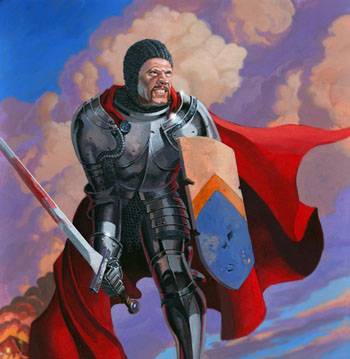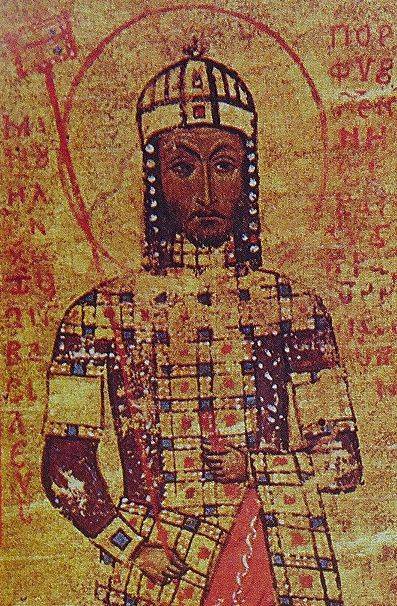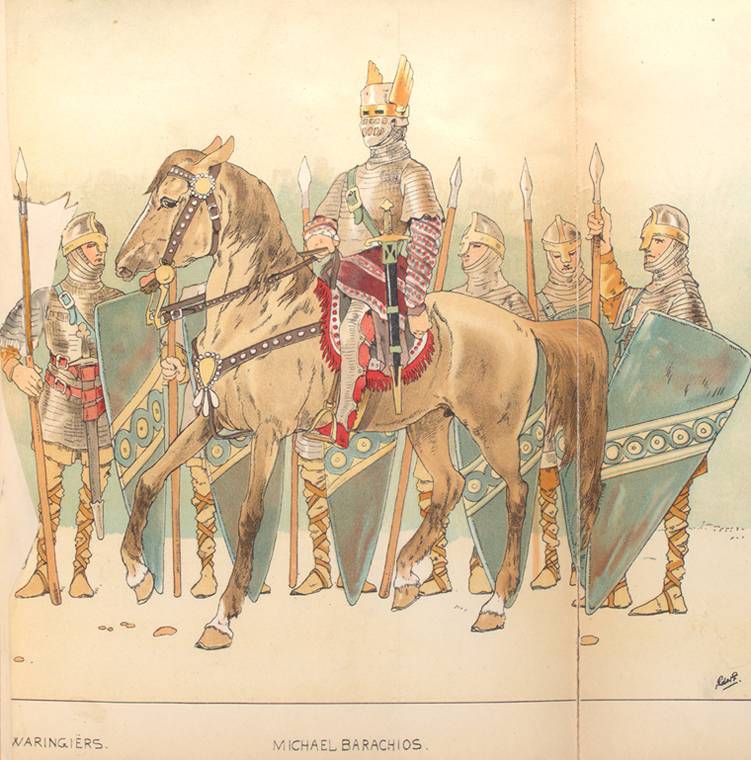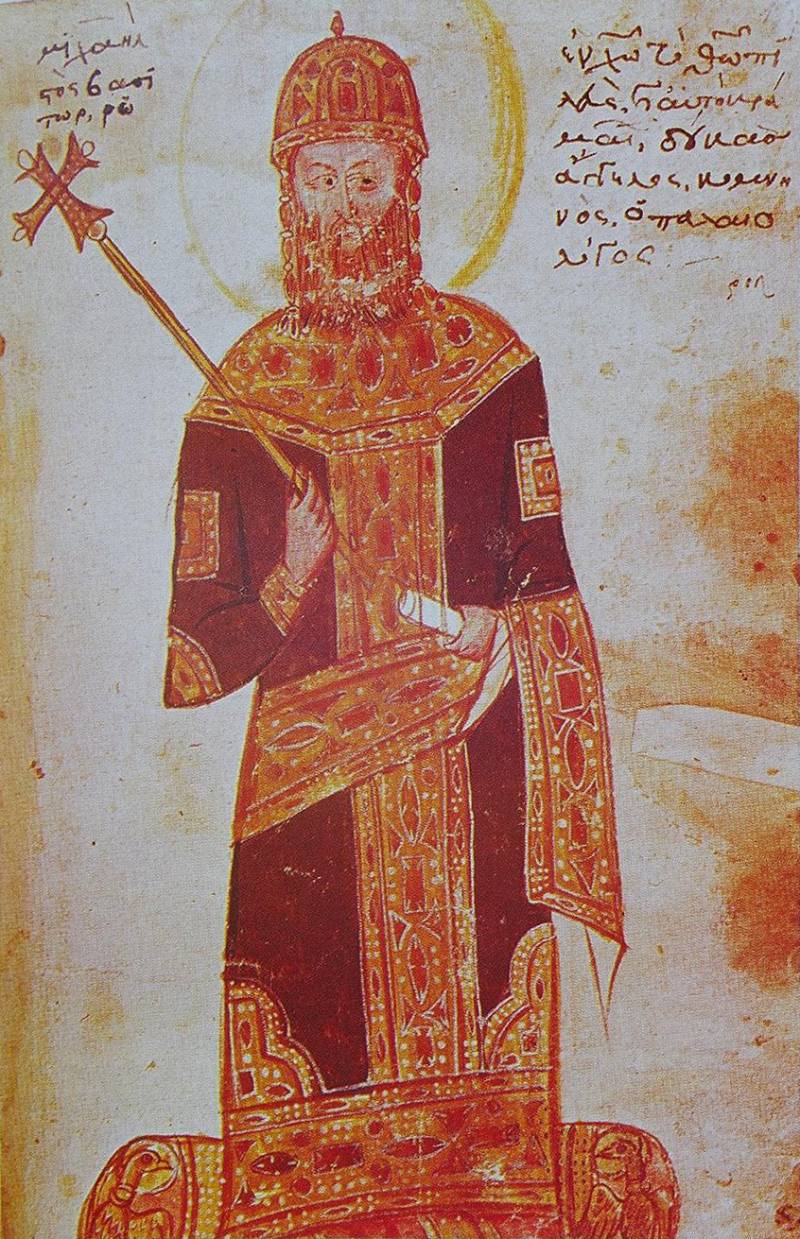Ax in the hands of the emperor. Battletrack Varangi. Part of 2
Gregory Bakuriani led the left flank of the Byzantine army, Nikifor Melissin led the right flank, and the center was personally the emperor.
The main strike force of the Byzantine troops was the Varangian Guard - at this time it was mainly served by the Anglo-Saxons, who fled from their homeland after the Norman invasion. She was on the left flank, and in the upcoming battle she was assigned an active role. Varangis received orders to advance in front of the main line of troops, letting the archers go ahead. The archers, having fired at the enemy, should have moved beyond the Varangian line.
When the opposing armies got close, Robert Guiscard moved the cavalry to attack - but the archers forced the horsemen to retreat. Then the Normans struck the junction of the center and left flank of the Byzantines. And then the Varang infantry counterattacked - the Normans were crumpled and ran.
The Normans were in a difficult situation - the right flank of their army was defeated. And the Varangians, who were cut with huge axes, overturned the knightly cavalry of Count Amico - there was a battle episode rather rare for the Middle Ages. The Normans rushed to the sea.
But the warlike wife of Robert, Sishelgaita, saved the situation, stopped the flight of the Normans with curses and threats. Hearing the loud shouts of a woman running toward them with a long spear in her hand, the Normans returned to battle. Bohemond arrived to the rescue, previously with his archers on the left flank.
Guards axes were moved too fast forward, moving away from the main forces of the Byzantine army. Moreover, Robert perfectly understood that his most dangerous enemy was tired and could hardly breathe - after a quick movement for a considerable distance, taking into account the armor and weapons. And the tired Varang received a flank attack from the enemy shooters. Having upset the ranks of Varangs with a hail of arrows, the Normans attacked them with their heavy infantry and cavalry.
A Norman source recorded that "the British, who are called Varangs," delivered a lot of trouble to the enemy. But, having received a blow to the right flank, after a fierce battle covered with blood, Varang began to retreat.
During the battle and retreat, the Varangian Guard was killed almost at full strength. She was cut off from the main Byzantine forces - and she did not wait for help. Many guards fell from the arrows, many tried to escape in the temple of the Archangel Michael. Varygs stubbornly defended the church, and some even climbed to the roof. The Normans set fire to the church, and, after the roof collapsed, many Varangians died in the fire. But the survivors, running out of the conflagration, died in battle.
In the battle of Dyrrachia, the Varangian Guard, who possessed high motivation and fighting spirit, served as a shock. The main task of the heavy infantry - to become the basis of the combat order, giving it stability. Varanga, in fact, performed the shock task of heavy cavalry, but even in this non-standard situation, achieved brilliant success. She made a turning point in the battle - but the Byzantine command, due to the lack of reserves, could not use success - the mobile reserve, which could build on success and pursue the enemy, while the guard was clearing up, was absent. There was also no general reserve - in order to help out the battles surrounded by warangs and turn the scales in favor of the imperial weapon. The Byzantine command failed to use the tactical advantage presented by Varanga. The pace and time were missed - and the Byzantines could not withstand the onslaught of the enemy, especially after the death of Varangi. Failure with Dirrachii - the failure of the Byzantine command, and not the courageous varangus.
Among the tactical factors of the death of the Varangian Guard should be highlighted the fact that played the role of 15 th years earlier in the battle of Hastings. In the battle, the Anglo-Saxons (in 1081, in the Varangian Guard, there were also most of them) were also weakened by shooting the Norman archers - and then the enemy heavy cavalry rushed into action. When Dirrahii this, in fact, a mirror, the situation is also aggravated - archers shot the Varangian Guard in the flank. As we wrote earlier, the chain mail, which was the main armor in the period under review, did not provide reliable protection against arrows at the 50-meter (and closer) distance. Moreover, during the attack, the monolithic system (Varangus at Dirrahii, hozarlov at Hastings) was upset.
In this battle, the empire lost its warriors to 5000 (overwhelmingly varangi). The Norman losses are unknown, but sources point out that they were very significant.
But the victory at Dirrachia became for the Normans Pyrrhic - the Byzantines subsequently won the victory at Larisa, and then during the 4 years the Normans lost all the fruits of their success.
In 1085, the Varangas were in the imperial army, defeated by the Pechenegs under Silistria (Balkans).
In 1087 - 1091 Varangian Guard participated in the campaigns of Alexei Comnenus. Under the rule of this sovereign Varang, as in the epoch of Vasiliy the Bulgarians, they were in constant campaigns and battles. Especially distinguished varangs in the battles of Drista (Drastar) and Levinium - during the Pecheneg campaigns. The first one ended with a heavy defeat for the Byzantines, but in 1091, at Levinium, the Pechenegs were crushed and suffered huge losses. And in honor of the 29 day of April, the Byzantines even put down a song in which there were words that “because of one day, the Scythians did not have to see May”.
In 1097, the Warang participated in the Anatolian campaign of Alexey Komnin. Managed to win Nikea. Next year - participation in the Asia Minor campaign.
1118 - 1122 - campaigns of John II Comnenus against the Pechenegs and the Turks.
In 1122, the famous Eski-Zagra battle took place. The Pecheneg hordes crossed the Danube - and on one of the Thracian valleys they met with the imperial army led by the basil. The Pecheneg Horde managed to block, the enemy surrounded his camp with carts, carts covered with ox-skins - and only John II at the head of the heavy cavalry tried to attack, they were hiding behind this kind of “wahrenburg”.
The battle lasted a long time, but the Byzantines could not break into the enemy camp. Sensing the crisis of battle, the emperor turned to the Varangian Guard. And guardsmen armed with long shields and axes went ahead - and chopped not only enemy wagons, but also steppe predators hiding behind them. The Pecheneg camp was captured and the remains of the horde were captured.
Nikita Choniates noted that the enemy left the wagons like strong walls, and then went out because of them and counterattacked. Thus, the battle turned into a real assault on the walls, suddenly erected among an open field. And then John showed his subjects a pattern of wisdom - taking his Guards, armed with axes, rushed at the enemy. The fortification was destroyed - and the battle became hand-to-hand. The Pechenegs turned into inglorious flight and died by the thousands.
The information of the Byzantine chronicler is confirmed by the data of the Scandinavian sagas - in the latter it is said that the imperial troops could not break through the defense of the Pechenegs. The entourage advised the emperor to introduce into the battle "wine skins" - that is, guardsmen-warangs. To this, the emperor replied that he was not going to "waste his precious stones." But the commander of the Varangians, Torir Helsing, declared that his soldiers for the emperor would gladly throw themselves even into the fire.
The battle of Eski Zagra was not only a crushing defeat of the Pechenegs. This is one of the iconic victories of Varangi.
The Pecheneg raid was the last - with the Pecheneg danger John Comnenus ended forever. Moreover, the memorable day of this battle for many years was celebrated by the Byzantines as a holiday.
1137 g. - during the siege of Antioch, the varangas were in the army of John. In this and further campaigns of the emperor, often ending with the siege of cities, the Varangas often performed the functions of sappers.
In 1149, the units of Varangi participated in the defense of Greece against the invasion of the Normans of Roger II of Sicily.
1155 - 1156 - units of the Varangian Guard inflicted a series of defeats on the Normans (the crusaders of the Prince of Antioch, Rene de Chatillon) during the fighting in Cyprus, and then participated in the triumphal procession of the basil Manus I Comnenus in Antioch.
The prince of Antioch, René de Chatillon, attacked Cyprus - the Varangians were also in the garrison of the latter. The economic and strategic importance of the island for the empire was very great. Cyprus is the richest and largest island in the Eastern Mediterranean. In the course of the Byzantine-Arab wars (60-s of VII century), more than once passed from hand to hand, mostly for almost 300 years remaining in Arab hands. In 965-966 The Romans returned the island.
De Chatillon was a cruel man. So, when the Patriarch of Antioch refused to give money for the Cyprus campaign, Rene beat the patriarch and then pulled him onto the roof, smeared the wounds with honey and left the flies to be eaten. An experienced warrior, in the spring of 1156, Mr. de Chatillon landed in Byzantine Cyprus, and defeated the troops of the governor-nephew of the emperor. The soldiers robbed, killed old men and children, injured prisoners, raped women.
But after initial successes, de Chatillon was defeated by the troops of Manuel and captured. The imperial troops marched in a triumphal march along Antioch, and one of the first European brave men, captured by varangians, “the Frankish demon” with a noose around his neck, sprawled at the feet of the basilica, recognizing himself a vassal of Byzantium.

Rene de Chatillon (1124 - 1187) - participant of the 2 th crusade, French knight, prince of Antioch. Being defeated by the imperial army, pleaded vassal of John II Comnenus.
08. 07. 1167 Varangian units participated in the battle of Sirmium, when the Byzantine imperial army defeated the troops of the Hungarian kingdom. The Byzantine building center was made up of Imperial Guards regiments (Varanga — the basis of combat order), a detachment of Lombard mercenaries, 500 heavy Serbian infantrymen and Wallachian cavalry. At the crucial moment of the battle, the Varang counterattack brought victory to the Byzantine weapons. 800 Magyars (including 5 princes - Zhupanov) were captured.
1172 - participation in the sea voyage against the Venetians.
11. 09. 1176 - the battle of Miriokephalus. The army of Manuel - the last great Comnenus - was surrounded by the Turks on a mountain road and suddenly attacked. Surrounded by and terrible carnage, which took away the color of the imperial army (including the klebanofor disappeared from the army lists since then), the guard took the brunt of the attack. The sacrifice of the best fighters allowed the troops and the emperor to escape. The Byzantine Empire moves to a strategic defense.

Manuel I Comnenus (28. 11. 1118 - 24. 09. 1180) - the emperor of Byzantium, the last Great Comnenus. With the help of an ambitious foreign and military policy, he sought to restore the status and glory of the empire. Fought in southern Italy. Joining forces with the Kingdom of Jerusalem, he made a trip to Fatimid Egypt. Manuel provided a protectorate of the empire over the Middle Eastern countries of the Crusaders and the Hungarian kingdom, and guaranteed security on the eastern and western borders of the empire. At the end of the reign, the emperor's successes in the east were compromised by the defeat at Miriokfale. Saved in this battle by his guard
In 1179, the Waranga participated in the victorious battle of Claudiopolis.
In 1203, the crusaders made their first attempt (through the Golden Horn) to enter Constantinople. But they could not overcome the resistance of the Vikings and the Pisans. Varangi was responsible for the defense of the section of the fortress wall and the tower. 17. 07. crusaders destroyed the dam, but were discarded.
During the storming of Constantinople, Varang was the most efficient part of the Byzantine army. The source mentions an episode when the Varangian Guards captured several knights, delivering them to Emperor Alexei III Angel. The resilience of the imperial Varangus led to the fact that several quarters remained in the hands of the imperial troops - and negotiations began.
After the fall of the capital, the Varangians served the empires in exile - the Nicene (1205 - 1261), as well as the Epirus despotatu. The glory of the Varangian Guard was so significant that even the Latin emperor of Constantinople acquired a regiment of the Vikings.
In the battles of the 1 th half of the XIII century. Varang promoted the unification of the empire and the rise to power of the Paleologos dynasty.
In 1205, sources note the fact that the Varangian unit was in the service of the Nicene Empire.
1233 - participation in the campaigns of John III against the Latin Empire. Capture Thessaloniki.
In 1264 - 1265 the battle took place at Makriplag (defeat from the Franks) and the defense of the city of Ainos (from the invasion of the Bulgarians - also unsuccessfully).
During the rule of the Paleologue dynasty, the units of Varangi are deployed in strategically important strongholds and regions of the state - on the Anatolian coast, in Thrace, even in Kherson in the Crimea.
Prior to 1272, Emperor Michael VIII actively used the Varangian Guard in his campaigns to collect land in Asia Minor and the Balkans.
Mikhail VIII Palaeologus (1224 / 1225 - 11. 12. 1282) - Emperor of Byzantium from 1261 (Emperor Nikaia from 1259), founder of the Palaeologian dynasty. In 1261, he conquered Constantinople from the Crusaders, reviving the Byzantine Empire. Miniature

Michael Varang VIII. From the collection of drawings Vinkuizhena.
From the 2 th half of the XIII century. Varang gradually becomes the palace guard - and the role of the latter is limited to the protection of the monarch and participation in ceremonies. The units of the Varangian Guard do not participate in military campaigns - having transferred this function to the Catalan Guard. This is due both to a decrease in the participation of emperors in hostilities, and a decline in the military activity of the empire, and economic problems (the latter turned the powerful warhead into a small palace unit). But in the June letter 1402, the emperor John VII informed the English king Henry IV that the "English" soldiers were actively involved in the defense of Constantinople against the Turks.
To be continued

Information